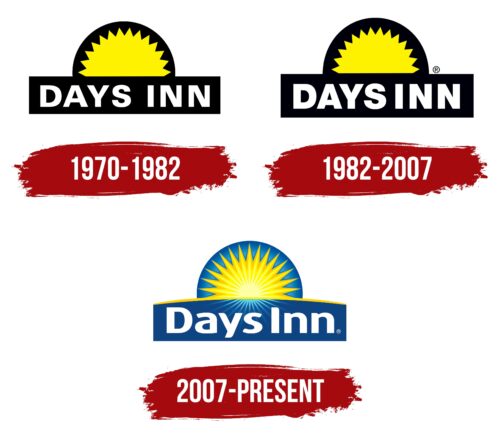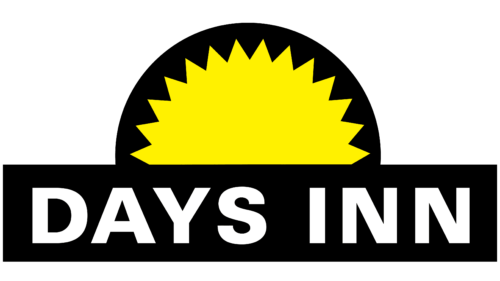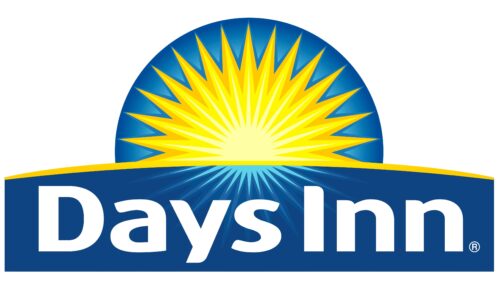The modern version of the Days Inn logo reflects the company’s key principles and priorities. While it has evolved, it has retained its core meanings, adopting a unique style with each iteration. The latest brand identity transformation demonstrates a contemporary approach, with three key elements drawing attention. The first is the image of the sun, which is symbolic: the light represents the growth of the hotel chain, and its bright rays are associated with relaxation. This symbolism combines comfort, coziness, and warmth, suggesting that staying with the Wyndham Hotels group will always leave pleasant memories.
The hotel name, placed at the bottom of the emblem, appears to be illuminated by the sun’s rays, emphasizing the chain’s reliability, stability, and high level of service. The logo conveys a sense of safety and confidence that everyone will find a comfortable resting place.
The color palette, featuring blue, light blue, and white, creates a harmonious combination, reinforcing associations with nature and relaxation. These natural tones add a sense of calm and freshness, reminding guests of the brand’s primary mission — to provide a comfortable and relaxing stay for all visitors.
Days Inn: Brand overview
Days Inn’s history began in 1969 when Cecil B. Day, a former real estate developer from Georgia, decided to open his hotel. He was inspired during a family trip to Florida, where he became frustrated with the lack of affordable and comfortable accommodations for families. Recognizing a gap in the market, Day envisioned a chain of motels offering clean rooms at reasonable prices.
1970, the first Days Inn opened on Tybee Island, Georgia, near Savannah. With a nightly rate of $8, significantly lower than industry standards at the time, the hotel initially raised some doubts. However, the affordable pricing and clean accommodations quickly won over guests.
Following the success of the first location, Day expanded rapidly, opening seven more properties along the Georgia coast by the end of 1970. Each hotel offered free coffee and newspapers—uncommon perks at the time—setting the brand apart from competitors. In 1972, the company began franchising, accelerating its growth. Day implemented strict franchisee guidelines to ensure consistent quality across all locations. By 1974, the chain had expanded to over 60 hotels.
The business continued to innovate during the mid-1970s. In 1975, it introduced the “Inn, Inc.” concept, offering rooms designed for business travelers, complete with features that doubled as small offices. This idea was ahead of its time and attracted a new demographic.
By the late 1970s, the chain was one of the fastest-growing hotel brands in the U.S. In 1979, the company celebrated the opening of its 300th hotel. That same year, the business expanded internationally by opening its first hotel outside the U.S., in Canada.
Throughout the early 1980s, the company continued to grow and diversify. In 1981, they launched a low-cost hotel brand called “Lodging for Less” and acquired the Carrols restaurant chain. These moves were designed to increase the company’s reach across multiple market segments.
In 1984, Cecil B. Day sold his company to a group of investors led by Richard Katz for $590 million—one of the largest transactions in the hotel industry at the time. Under new ownership, the business continued to thrive.
1989, the company entered the mid-range hotel market by acquiring the Amerhost Inn chain. By the late 1980s, the brand had over 1,000 hotels in operation.
However, the early 1990s were challenging. The economic downturn and oversaturation in the budget hotel market led the company to file for Chapter 11 bankruptcy in 1991. Despite financial difficulties, the brand continued to grow.
In 1992, Hospitality Franchise Systems (HFS), which later merged with Cendant Corporation, acquired the brand. The new ownership revitalized the company, investing in hotel upgrades and improving service quality.
In the mid-1990s, the chain expanded into international markets, opening hotels in South America, Europe, and China. In 1997, the company also embraced the digital age by launching its first website, allowing guests to make online reservations.
Throughout the 2000s, the hotel group continued to evolve under Cendant Corporation. In 2006, Cendant’s hotel division was spun off into Wyndham Worldwide, which took over brand management.
Under Wyndham’s leadership, the hotel chain focused on property renovations and improving the guest experience. In 2008, they launched the “Daybreak” room renovation program to modernize and refresh its hotel interiors.
By 2010, the brand had grown to over 1,800 hotels worldwide. To celebrate its 40th anniversary, the company launched a marketing campaign highlighting its history and commitment to offering affordable, quality service.
In 2011, the chain introduced the Wyndham Rewards loyalty program, allowing guests to earn points and redeem them for free stays across the Wyndham network. This program became a key tool for attracting repeat customers.
2015, the company rebranded with a new logo and updated its interior design. These changes aimed to modernize the brand and appeal to younger travelers.
A significant organizational change occurred in 2018 when Wyndham Worldwide split into two publicly traded companies: Wyndham Hotels & Resorts and Wyndham Destinations. The hotel brand remained under Wyndham Hotels & Resorts, which allowed the company to focus exclusively on its hotel operations.
In 2019, the business continued its global expansion, opening new hotels in countries like the Philippines and India, further solidifying its international presence.
By 2020, the company operated over 1,700 hotels across more than 25 countries. Despite global challenges in the hospitality industry, the brand continued to adapt.
In 2021 and 2022, the focus was on enhancing its guest experience through technology. The company improved its mobile app, offering contactless check-in and check-out options and other features to make stays more convenient.
As of early 2023, the brand remains one of the leading names in the economy hotel sector. Staying true to its founder’s vision, the company offers clean, comfortable accommodations at affordable prices. Over its 50-year history, the business has grown from a small chain of motels in Georgia into a globally recognized brand. Despite changes in ownership and management, the company has maintained its commitment to delivering value and quality service to millions of travelers worldwide.
Meaning and History
What is Days Inn?
This is a well-known budget hotel chain that offers affordable accommodations worldwide. Guests are provided with cozy and reliable lodging, which appeals to budget-conscious business travelers and families on road trips. Many of the chain’s hotels offer free breakfast and free Wi-Fi, as well as mini-fridges and microwaves in the rooms. The “Daybreak” breakfast is a popular feature that helps guests start their day well.
1970 – 1982
The first logo was introduced in 1970, and its primary purpose was to serve as an informational guide for potential customers. With just two words and three colors, the emblem conveyed the message: Days Inn guarantees a great stay for both travelers and frequent business commuters.
The text, displayed in large white letters, occupied the lower part of the logo, with an image of the sun positioned above it, gently blending into a geometric shape. A black rectangle filled the background, creating contrast with the sun, and the entire composition was enclosed in a frame. This frame symbolized unity, completeness, and orderliness of all the elements, conveying a sense of harmony and wholeness, which aligned with the brand’s promise of rest and reliability.
1982 – 2007
In 1982, the chain’s brand identity was updated, giving the logo a distinct individuality and style aligned with the company’s dynamic growth. The visual design became sharper and more memorable, reflecting the hotel chain’s ambitions.
The color palette remained unchanged: the three primary colors continue to emphasize the key aspects of the brand. Each plays an important role, providing aesthetic appeal and functional clarity to the logo. The bright yellow symbolizes radiance and growth, highlighting that the brand continues to expand. It also evokes associations with relaxation and comfort, connecting the brand with the idea of providing convenience and ease for its guests.
The geometric shapes in the visual mark create a sense of balance and stability. The circle surrounding the sun smoothly transitions into a rectangle, symbolizing evolution and completeness. The bold white letters draw attention with their clear expressiveness, almost magnetically holding the gaze and emphasizing the seriousness and reliability of the brand.
2007 – today
The Days Inn hotel chain logo, introduced in 2007, symbolizes the brand’s revival and growth. At a time when the chain already encompassed over 140,000 rooms worldwide, the company decided to update its identity to reflect its expansion and modernization. The logo now presents a more intricate and artistic composition, representing the development and variety of services the hotel chain offers. Each detail became more expressive, and the logo’s elements gained additional depth.
The rising sun remains the central element of the emblem. This symbol is directly associated with the start of a new day and fresh energy, perfectly conveying the brand’s key concept—providing comfortable rest and renewed strength for every guest. In the updated version, the sun is depicted with more detail: bright rays radiating outward create a sense of motion and dynamism, emphasizing the brand’s commitment to growth and offering a wide range of services.
The color palette now consists of yellow, white, light blue, and dark blue, which blend well to highlight the text and the image on the background. The sun’s yellow represents warmth, joy, and hospitality, while the background’s blue tones add stability and confidence. These colors evoke feelings of reliability and calmness, essential for a hotel chain to prioritize comfort and care for its guests.
The text portion of the identity is rendered in clean white against a blue background. The font is simple yet bold, creating a sense of stability and confidence. The name “Days Inn” underscores the brand’s primary mission—providing guests with a comfortable stay at any time of the day or night.
Another important element of the visual mark is the line running above the hotel’s name. It symbolizes the division between night and day, highlighting the importance of restful sleep and the start of a new day at the hotels.
This emblem became a symbol of the brand’s renewal and ambitions. It conveys the hotel’s core values—comfort, hospitality, and reliability—while reflecting its drive to move forward and offer its clients new, high-quality services.







